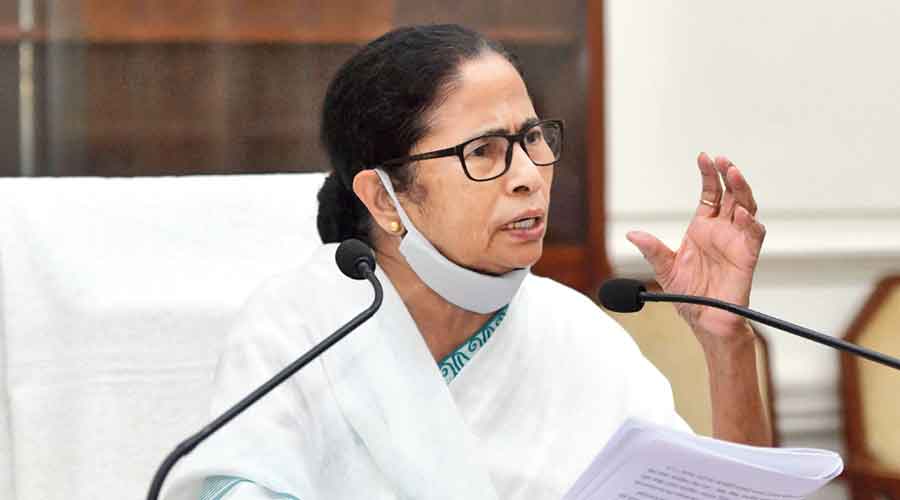The Mamata Banerjee government assigned outlays to fulfil the promise of universal basic income (UBI) for the marginalised and the needy in the state budget for 2021-22 that industries minister Partha Chatterjee placed, filling in for ailing finance minister Amit Mitra, in the Assembly on Wednesday.
It was clear from the 18-page statement of intent, which Chatterjee read out in less than 30 minutes, that the theme of the budget was Mamata’s plan for transferring cash directly to as many people as possible.
“Since the time of demonetisation, people have not been able to spend…. So, our effort is to hand out cash to them so that they can spend, which will result in creation of demand, trigger economic activity and result in growth,” Mamata told The Telegraph, explaining the broad direction of the budget.
The attempt at unlocking demand was evident in the proposals made in the form of reduction in stamp duty and circle rate, which come into effect during transaction of land, houses or flats.
Mamata’s desire to enable people to loosen their purse strings was captured in the details. The budget documents revealed how the government has increased outlays to some departments to ensure the objective of UBI, which means paying citizens an unconditional monthly sum.
For instance, the women and child development and social welfare department, the outlay of which has been pegged at Rs 16,045 crore, has been earmarked more than 2.7 times the sum in the last budget. The objective is to offer a monthly amount of Rs 500 (Rs 6,000 a year) to general category households and Rs 1,000 (Rs 12,000 a year) to SC/ST category households directly to the bank accounts of the female heads of 1.6 crore families in the state.
Similarly, outlays have been significantly raised for departments like agriculture and school education to ensure payment of Rs 10,000 each to over 62 lakh farmers every year and transfer of Rs 10,000 each to over 10 lakh students in Classes XI and XII so that they can buy tabs to continue studies online.
Mamata said the cash transfer was not limited to these sets of people. “There are a whole host of other direct cash transfer schemes like pensions for widows, artists and other categories, monthly doles for farmers and others…. No other state has had such a wide range of direct transfer schemes,” the chief minister said.
The apparent political reason behind the focus of the budget can be easily gauged as the Assembly election results had proved beyond doubt that women, beneficiaries of various pension schemes like SC/ST, senior citizen and widow stipend, had helped the ruling party in ensuring a rout of the BJP in the bitterly contested battle for Bengal.
The subtle trigger behind the proposals seems to be Mamata’s attempt at sending out a message that her government — unlike the Narendra Modi-led Centre — is following a welfare approach by addressing the immediate concerns of the deprived sections of the society during the pandemic.
Several prominent economists had advocated the need for direct cash transfer in the time of the pandemic to insulate migrant workers, farmers and other weaker sections of the society from the impact of the slowdown of the economy.
“Unlike them, we are trying to create demand and help poor people…. We believe in economic policies with a human face. The Union government owes us more than Rs 60,000 crore, but still they are not releasing the funds. But that has not stopped us from delivering on our promise,” said Mamata, who accused the Modi government of making the lives of common people difficult by allowing fuel prices to spiral.
Trinamul insiders expressed the hope that the Bengal budget’s broad welfare direction — with high allocations for other departments like school education and health and family welfare — would help her steal a march on the Modi regime.
The fact that the Union government’s policy has had little impact on reshaping the Indian economy while Bengal surged ahead was mentioned in the budget document. “While growth of GDP of India dipped to negative 7.7 per cent in 2020-21, Bengal’s GDP clocked 1.2 per cent growth,” read the budget speech.
The Bengal government’s claims about its better economic performance in comparison to the Centre came under attack from the BJP whose position was articulated by party MLA Ashok Lahiri, an economist and former chief economic adviser to the Union government.
“Different states calculate their respective GSDPs in different methods. These aren’t comparable. This is why the National Statistical Office calculates comparative data on this. The state finance minister has claimed that from 2010-11 to 2019-20, there has been a 2.94 times increase in our GSDP. This is untrue. It has increased by 2.40 times only. He has also claimed that during 2019-20, the GSDP growth rate of Bengal has been more than the GDP growth rate of India. This is true. However what he didn’t say is that for a long period from 2012-13 to 2018-19, every year the rate of GSDP growth in Bengal has been lower than the national GDP growth rate. Thus, we must conclude that Bengal is lagging behind,” he said.
Although this is not the first time that Bengal’s macroeconomic data has come under attack, both Mamata and finance minister Mitra — who joined a post-budget news conference virtually — stressed that the state’s economy has been on a steady growth path and would achieve an even higher trajectory because of the budget’s proposals aimed at demand creation.
The idea of a demand-driven recovery also seems to be the basis of the revenue-side budget arithmetic that has projected a 26 per cent increase in the state’s tax revenue without levying any new taxes.
The government is also confident that its emphasis on job creation — the budget document claimed that over 1.5 crore jobs would be created in the next five years — would further fuel the economic growth in the state.











